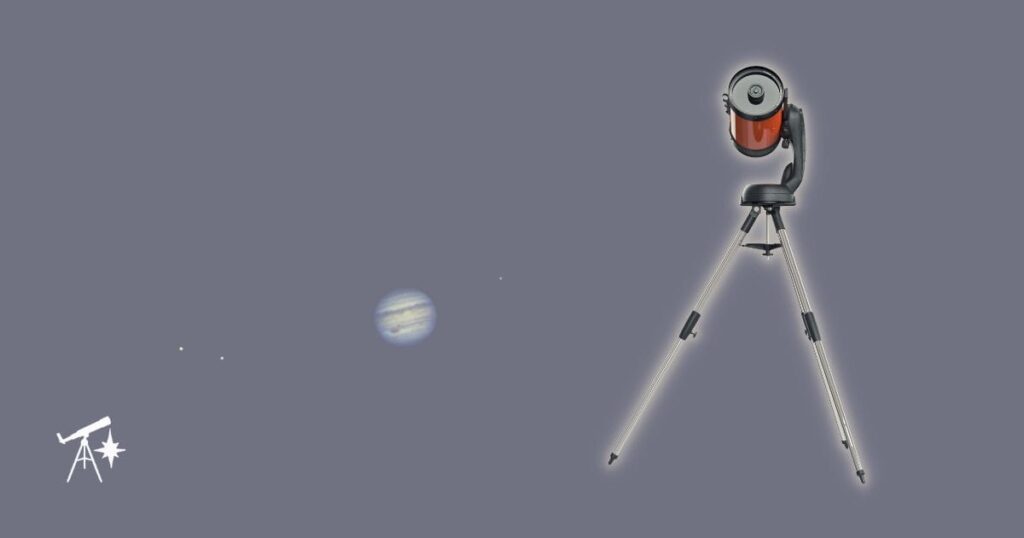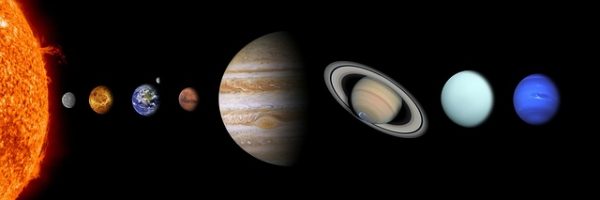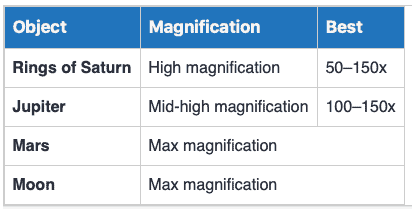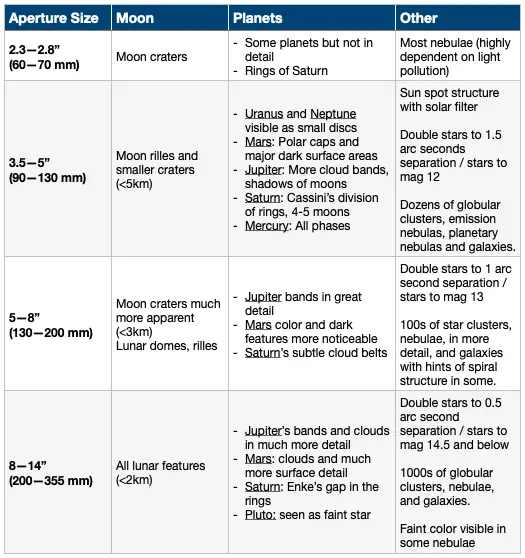With so many telescopes out there, it’s hard to know which one to buy for that experience you yearn for. Many budding amateur astronomers want to observe planets through a telescope. The following covers what to look for in a telescope to view planets and other distant objects in the night sky. It reviews some popular telescopes including the Go-To telescopes (automated types).

Who is this for? Anyone interested in observing the planets through a telescope and getting good views of planetary features.
Choosing the right telescope for planetary viewing
What’s the best telescope for viewing planets? The best telescope for planetary views is a reflecting telescope with an aperture of 6″ or more, or a 3–5″ refractor, with high-quality optics, and a smooth-moving rock-steady mount.
There is no perfect telescope for everyone. What to look for in a telescope for planet viewing is one with enough power to give you decent observations of Jupiter and its transiting moons and Saturn with its rings defined. Not only will you have a telescope for viewing planets but also one for viewing lunar features.
If you want the best bang for the buck, consider getting a Dobsonian, with its many advantages for beginners.
For starters, it’s simple to use. Scaling up, opt for Gotos, for truly automated planetary viewing. These include Celestron’s computerized CPC and Celestron’s 6SE GoTo that’s compact.
If you’re a fan of the refractor type of telescope, the SkyWatcher APO is a powerful telescope. Details on these are below.
Cost for a telescope to see planets
The price of a decent telescope for planet viewing varies. In this telescope buying guide, they range between $300 and $4000.
If you’re looking for something cheaper as a choice for beginners, see my article on telescopes under 200. These are smaller budget telescopes with simple alt-az mounts and cheap tripods and accessories.
These cheaper beginner telescopes are not the best telescopes for observing the features of planets in finer detail.
They are better for Moon crater observations, but with skill and the right conditions you could get to see the rings of Saturn or glimpse the cloud bands of Jupiter.
An 8″ Dob is an excellent choice that’s a good affordable beginner’s telescope for planet and galaxy viewing. Then there is the type of telescopes with automated mounts vs manual controls.
These are more expensive but the extra dollars in layout might be worth the convenience of less time spent fiddling with the controls to locate and track your target object, as it moves out of the original view with Earth’s rotation.
What to see of planets through a telescope
What Planets Can I See Through My Telescope? You can see all seven planets in our solar system with the right home telescope, though you’ll need a fairly large aperture to see the dwarf planet, Pluto, and then only as a disc.

The following chart of aperture size against planetary features and star clusters, and other deep sky object types gives you an idea of the rule of thumb on what to expect when looking through a reflector telescope at the night sky in your backyard (providing it’s away from city lights).
Note: Results will vary with telescope optics, phases of the moon, skill levels, timing, and atmospheric conditions.
One thing…Don’t expect to see views of distant objects like the nebulae captured by NASA, which are amazingly beautiful images. Those are from high-powered space telescopes and not the detail you are likely to see through a home telescope. Here are some features of planets to look for:
- Polar caps and major dark surface features — Mars through a telescope.
- Colored bands and its moons — Jupiter through a telescope.
- Rings and the largest moons that are faintly seen at varying times — Saturn through a telescope.
- Blanket of thick cloud — Venus through a telescope.
The moons of the distant planets, Uranus and Neptune, are more challenging to find, but you might see them with a higher aperture telescope.
Things to consider when looking for a planet telescope
The following is a guide on what to look for when choosing the best planet telescope for you.
>> See also my tips on observing planets
Aperture Size: The aperture size is important but the average useful aperture size for viewing planets will differ with telescope type, e.g., reflector vs refractor, or Cassegrain, and the target planet. What size telescope should I get to see all the planets in our solar system? Here’s a guide:

In general, the larger the aperture the more light will be captured by the primary mirror (or objective lens), and the brighter the distant planet will appear. A good finderscope is important for aligning the scope for views of the planet. This means an 8″ reflector might give you better views of the planets (for Moon viewing you’ll need a gray filter).
Magnification of telescope: What do I need to see planets?
The magnification to see planets and their features can vary from 30x to 300x depending on your target object, the night conditions, and the telescope’s optics. Know the minimum and maximum limits of the telescope’s usefulness, which are usually listed. Going beyond these will distort views.

See my tools page for a magnification calculator to work it out.
Optics: Look for good-quality optical components of the telescope, including the primary objective, secondary mirror, and focusing assembly. Expect high quality from the better-known brands of telescopes, such as Celestron, Orion, and SkyWatcher (see my comparison of these brands).
Eyepieces & Barlow lens: Typically, the eyepieces that come with the telescope won’t cover all magnifications or they may not be the best quality. You’d probably want to buy one or two good quality extra eyepieces with the purchase (learn more here). Also, a Barlow lens can double the magnification of an eyepiece — see my article on using Barlow lenses.
Telescope mount: The mount supports the mass of the telescope and so having a stable one will reduce the amount of manual tweaking you’ll need to do to keep a firm base. Simplicity and functionality is what matters most with mounts, says Dickinson.4 You need a mount that moves smoothly yet stays put where and when you want it to.
The main types of mounts are alt-azimuth (Alt-Az) and equatorial (EQ). You can find out what there is to know about telescope mounts in my articles explaining the pros and cons of different telescope mounts and mounting a telescope on a camera tripod.
In a nutshell…
An equatorial mount uses either the north or the south celestial pole as a point of reference for alignment. They allow movement in east-west and north-south arcs. The alt-azimuth mount types involve centering the eyepiece on an ‘alignment object’. This type of mount provides for altitude (up and down) and azimuth (side to side) movements. It is problematic for astrophotography.
Automation – GoTo types: GoTo types automate finding planets by going to the celestial location of the object using coordinate data entered in the inbuilt computer. They then can track celestial objects, which is useful for astrophotography. These have motorized mounts, either equatorial (EQ) or alt-azimuth. They tend to be more expensive than manual types.
Portability & Storage: Before making a purchase ask yourself where you plan to use and where to store the telescope when not in use. If you live in a small apartment, for example, you may not have enough room or may need offsite storage for a large telescope.
What to watch: With a larger-sized aperture, think about the portability and storage of the telescope. These things can limit your use — see my telescope storage ideas.
Ask yourself where will you be using the telescope. Do you intend to travel with your telescope? A compact telescope suits travel and limited storage. Refractors, for example, generally weigh less than reflectors and SCTs are not as bulky.
I wrote about the advantages and disadvantages of refractors vs reflectors.
For a compact telescope for planet viewing, the NexStar 6 SE is a good choice if portability is important and storage space is limited.
Best planet viewing telescope reviews
In all of these, Dobsonians will give you the best bang for your buck.
8″ Dobsonian telescope

Sky Watcher Classic
available at Amazon (affiliate link)
For more information on the Dobsonians, step over to my article covering the Dobsonian advantages and disadvantages. The Dobs are a great planet-viewing telescope, for the price-conscious and the beginner. Especially, if you are looking for something low-cost with simple mechanics and aren’t at the stage of astrophotography, it’s a good choice.
Celestron NexStar 127SLT Mak review

Included in the NexStar 127SLT
available at Amazon (affiliate link)
Celestron is a Californian company that has been in the optics industry for decades.
This computerized (Go-To) telescope has a corded hand controller and is attached to a motorized alt-azimuth mount that sits on top of the tripod. The SLT stands for ‘star locating telescope’.
The advantage of an alt-azimuth motorized mount is that it can find the point from the entered object’s altitude and azimuth and quickly gather the sights for you automatically, so you don’t waste time hunting for them or having to manually align the telescope.
A Maksutov-Cassegrain (Mak) of this size, 127 mm (5″), makes it suitable for planetary viewing.
With this particular scope, you should see rings on Saturn, the bands on Jupiter (and possibly the Great Red Spot on a clear night) with sharp enough focus. You should see the reddish hue of Mars.
The advantage of Maks is that they don’t require collimation (alignment of the optical elements). They are fairly rugged for transporting.
A focal ratio of 12 indicates it is in the high power range for narrower field viewing, suited to viewing planets, binary stars, and small features of the moon.
Adding in an eyepiece with a 6 mm focal length will give you a potential magnification of 250×. Scroll down for a recommended add-on filter and eyepiece kit.
What is included: Telescope, tripod, control keypad, and two Celestron eyepieces: 9 and 25 mm. Extras included: Finderscope – StarPointer; Star diagonal 1.25; Includes “The SkyX” Planetarium software.
Pros:
- Ticks all the boxes, with a high focal ratio and a good size aperture
- No collimation
- Fairly rugged
Cons:
- Watch for aberrations
- Maks are not recommended for deep-sky objects
- Not best for astrophotography.
Price & where to buy
- Check out the latest price of this Go-To telescope at Amazon — See details (affiliate link).
Recommended addons
Car battery adapter
Buy an adapter that will let you power this scope from the cigarette lighter of your vehicle. An example is the Celestron car battery adapter that is compatible with Nexstar telescopes.
Extra eyepieces For Enhanced Views
Get extra telescope eyepieces for viewing planets.
With the Nexstar 127 mm instrument, a 6 mm piece is recommended. An eyepiece + filter kit, like the Celestron 14-pc telescope accessory set, has one this size, which will improve the telescope’s views of planets. The kit has 5 Plossl eyepieces (6, 8, 13, 17, & 32 mm), 2× 1¼” Barlow lens, 6 colored planetary eyepiece filters, a 1¼” moon filter, and a case. A huge saving for beginners.
Celestron NexStar 6 SE review

NexStar 6SE Telescope
you can see details at Amazon (affiliate link)
This planet viewing telescope is an automated catadioptric type (combines mirror and lens. I wrote about the benefits of these). It has a GoTo mount and a database of over 40 thousand night sky objects on which to automatically focus.
Simply use the built-in menu on the hand controller to select the celestial object and the telescope will automatically move and point to that object.
Being a Schmidt-Cassegrain (SCT), it shouldn’t suffer color aberration. Also, the SCTs are a jack of all trades.
The telescope comes with a sturdy steel tripod.
With this particular scope, you should see faint objects to magnitude 13.4. Expect to see Saturn and its rings through this telescope.
It only comes with one eyepiece, a 25 mm. So for planetary viewing consider adding at least one extra eyepiece and a 2x or 3x Barlow.
Extras included: Sturdy steel tripod, finder scope – StarPointer; SkyAlign allows you to align on any three bright celestial objects, making for a fast and easy alignment process; Nearly 40,000 object database with 200 user-definable objects and expanded information on over 200 objects.
Pros:
- Only one eyepiece included (magnification 60×)
- Skyalign works well with auto 2-star alignment
- Compact
Cons:
- Relatively short battery life of the 8 AAs used in the mount
- The mount being an alt-azimuth is not the best for photographing the planets, but you may succeed in capturing Venus, Jupiter, and a few others, with a very high ISO
Price & where to buy
- Get the latest price of this go-to telescope at Amazon — See details (affiliate link).
Sky-Watcher ProED 120mm Doublet APO

Sky-Watcher EvoStar
available at Amazon (affiliate link)
The APO stands for apochromatic, which means expensive optics are used in this telescope. These optics reduce the residual color you get with other refractor telescopes. With these, you get amazing sharp images. These refractors are premium instruments.
With this refractor telescope, you’ll need to buy the mount/tripod separately — it comes with attachments for these.
With this particular scope, you should see faint stars to a 12.9 magnitude.
With the maximum magnification of around 283×, based on the size of the aperture and telescope focal length, you’ll get nice views of Saturn’s rings and of Jupiter with the right eyepieces.
Other: Finderscope – 8×50 RA erect-image, Dual-speed 2″ Crayford-type focuser with 1.25″ adaptor; 20 mm and 5 mm 1.25, 2″ dielectric diagonal; Tube-ring attachment hardware; Aluminium carry case.
Pros:
- Schott Glass, an FPL-53 ED glass element
- Apochromatic ED doublet optics mean superb images — free of the annoying halo of unfocused violet light
Cons:
- The tube is relatively long for free hold
- You will need to add a mount and tripod (see below for a tripod with a computerized mount that you can add)
Price
More expensive than the previous two telescopes for viewing planets.
- Get the latest price of this telescope at Amazon — See details (affiliate link).
Recommended addons
If you are looking for a tripod for this scope, here are a couple of options…
Tripod with equatorial mount
A Celestron CG-4 German Equatorial Mount and adjustable height steel tripod will suit and easily maneuver this telescope to find the planets for viewing.
Tripod with programmable mount
A computerized mount and tripod will automate finding planets to view, like this Celestron Advanced VX Mount with Celestron Polar Axis Finder.
Celestron CPC 8″ Computerized Telescope
You’ll get full automation with this Schmidt-Cassegrain telescope, SCT. It’s one of the newest GoTo telescopes on the market and means you don’t need to do a steep learning curve to be out there stargazing and planet viewing.
It doesn’t require any set up with aligning the pole, no pointing north, no need to enter the date, time, or location. It has a global positioning system (GPS) in the mount that signals the computer where you are (within a few meters) and computes all that information you would normally enter.
Where to buy
- High Point Scientific has this CPC 800 as a bundle deal
But if you prefer Amazon…

Celestron CPC 800 see it at Amazon (affiliate link)
Still not sure? Here’s a Wizard…
Orion’s Product Wizard is a tool to help you select the best telescope or binocular to meet your personal needs
If you’re still unclear, try out Orion’s Wizard to take you through features to determine the best telescope for you.
Final thoughts
The brightest and nearest planets to Earth can be seen with the naked eye. There’s Mercury, Venus, Mars, Jupiter, and Saturn (in order of distance from the Sun) that fall into this category.
I wrote about how Mercury looks like a –1 magnitude star in my article listing the best windows of time for viewing Mercury through a telescope. Seeing the planets through a telescope adds a whole new dimension and having the right telescope will give you hours of enjoyment.
Info sources
- Stack Exchange: Astronomy Q&A |
- Time & Date: Night Sky Map |
- NASA: Planets in our Solar System
- Dickinson, Terence. 2019. NightWatch. A Practical Guide to Viewing the Universe. (affiliate link) Firefly. New York.

